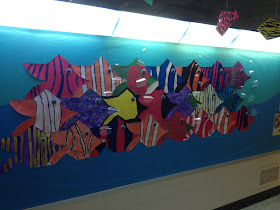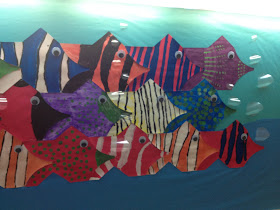Stacia and Amanda over at Collaboration Cuties have just posted a mentor text link up. I can't wait to browse through all of the mentor text recommendations they will be gathering! I am sure my pocketbook will suffer, but I can think of much worse addictions than that of buying books... :0)
The main mentor text that I am sharing is not one that I have in my classroom library YET, but I stumbled upon it in our school library. I had just finished a read aloud in our librarian's over-sized recliner, leaned forward to get up, and I spotted a title on the binding of a picture book that made me laugh, My Dog is as Smelly as Dirty Socks. I HAD to take a closer look.
Upon closer examination, I realized the book included a series of family portraits made with objects. How intriguing this was! Furthermore, the objects were all related to similes that a little girl used to describe her family members... "My daddy is as jumpy as a spring... He is as fun as a party favor...".
I immediately thought about the text's teaching potential in regards to similes. THEN, when I went online to purchase the text, I found out that the author, Hanoch Piven, has a website where people can post pictures of their own object art, AND there is an app called Faces iMake.
Here's the lowdown on My Dog is as Smelly as Dirty Socks: And Other Funny Family Portraits...
Using this text is on my list of to dos upon returning from spring break. We will strengthen our previous learning/understanding of simile when we create object portraits and writings using similes. Look for a post sharing student creations coming SOON!
Hanoch Piven also has a follow up picture book called My Friend is as Sharp as a Pencil: And Other Funny School Portraits.
Both picture books are available at amazon.com (text and Kindle versions) and Barnes & Noble (text and Nook versions). You can also view a preview of My Dog is as Smelly as Dirty Socks on amazon.com.
Don't forget to stop over to Collaboration Cuties and browse their Mentor Text Link Up!
Mentor text link ups will be going on by theme each week. Don't miss this fun opportunity to expand your teaching repertoire!




























